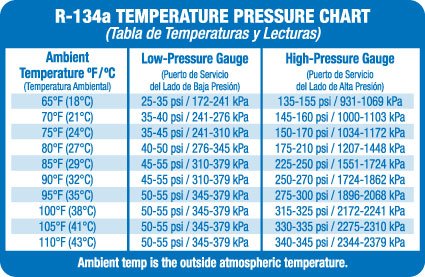@L31MaxExpress thanks for sharing more r152a information.i only recently took the plunge into AC repair about a year ago. got a vac pump, gauges and a can tap. when I did my fathers Pilot, I actually weighed the can with a digital scale and added what ever the 134a to 152a conversion was. would it be better to use a 134a pressure temperature chart to get in the ballpark and then top off using an IR gun to check the superheat? do you mind sharing your methods?
I think you will end up overcharged if you try to use a pressure temperature chart for a refrigerant you are not using. If you use R134a suction and head pressure for example, the R152a system will look to be undercharged, so you add gas go it. Now when you rev the engine, that extra refrigerant shoots the head pressure up and liquid returns to the compressor, which results in a bang and screech.
Your fathers Honda might be an interesting one as it probably has an expansion valve H-block amd a ECU controlled variable displacement compressor. It is difficult to get to the evaporator inlet and outlet on those.
What I did on my 2007 G35 is hooked up a scan tool and logged the target and actual evaporator temp. I added refrigerant until the suction line was a few degrees warmer than the evaporator core temp. What I find interesting in that car is it is programmed to target 26-30°F when the car is at max blower speed and recirculate max air function on. I have seen the vent temps in that car get down to 30°F. That car has a variable displacement compressor with a PWM solenoid to control displacement. I figure the Honda is probably similar if it is newer. If the discharge air is blowing say 40°F and the suction line is under 50°F, I would say it is probably close. Also look at the temperature variance between vents. If it has dual climate control, turn both temp settings as low as they go. Then compare the different vents. If one vent is signifigantly warmer than the other, it either has low refrigerant or a possible blend door problem. I only mention a blend door problem as a caution because it will create the same symptoms as my next statement. Assuming good blend door seal and actuator function, If the system is low on charge, the evaporator will have a colder spot and a warmer spot in it and it will show up as a big variance in vent temps.
I do own an IR gun and use it frequently, but I also check alot of this by feel. On a fixed orifice tube system I can feel when it is about right holding the cold side lines with my finger tips. Don't grab a high side line though as it can actually burn your fingers. Once the suction line and accumulator get nearly as cold as the evaporator inlet the system is adequately charged. I try to feel the suction line as close to the compressor as possible watching out for the belts, hot engine parts, the cooling fans, etc. On my Van and Tahoe, I usually make sure that the line entering the compressor is within 10°F of the evaporator outlet. You want all the liquid boiled before it returns to the compressor. I use the gauges to make sure that the system is operating within reasonable pressures.
Some of this is just experience and hard to put the right words to. I have worked around many aftermarket ac systems, farm equipment, older vehicles that have been retrofited, etc for over 20 years. Probably the oddest thing I have worked on was system rebuild and R134a retrofit on an engine driven cold plate freezer/refrigerator on a chevy 350 powered cabin boat that someone had failed to retrofit correctly prior and the compressor seized. That unit had a Sanden 508 and the thing used a water cooled condenser.


